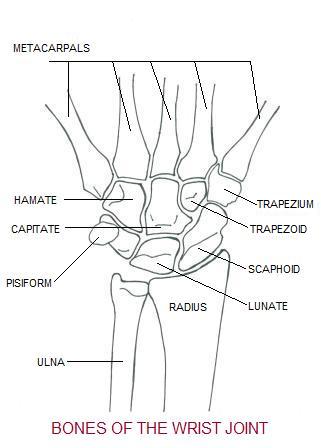Here is a discussion and common ailments for the wrist. Most of these conditions can be treated naturally with effective results.
The wrist anatomy includes the bones, muscles, tendons and other structures around the wrist joint. The wrist or the carpus is a part of the hand. It joins the forearm bones with the metacarpal bones of the hand. It is made of 8 small bones called the carpal bones (http://www.joint-pain-expert.net/wrist-anatomy.html).
These are:
• scaphoid
• lunate
• triquetral
• pisiform
• trapezium
• trapezoid
• capitate
• hamate
• trapezoid
• capitate
• hamate
These bones are arranged in two rows. The proximal row includes the scaphoid, lunate, triquetral and pisiform. The distal row includes the trapezium, trapezoid, capitate and hamate.
Towards the palm the bones of the wrist form a concave cavity. This cavity is completed into a tunnel by the flexor retinaculum. This tunnel is called the carpal tunnel. It provides passage to the flexor tendons of the fingers and the median nerve. At the back of the wrist these bones are convex.
The scaphoid, lunate and triquetral bones articulate with the articular surface of the lower end of the radius to form the radio-carpal or wrist joint.
The radial artery crosses the wrist joint and is the main blood supply of the hand. The radial pulse can be palpated at the wrist by gently pressing over the lower end of the radius bone.
The ulnar artery and nerve also cross the wrist joint through the ulnar tunnel. This ulnar tunnel is formed by the superficial and deep parts of the flexor retinaculum.
Each finger of the hand is powered by a completely separate system of muscles and tendons which are located in the fingers, wrist, and forearm. Most of the hand’s power is generated by larger muscles in the forearm while finer movements are controlled by smaller muscles in the hand itself. Our wrist is the bridge which stabilizes the interaction of the hand & forearm (http://www.ultimategripstrength.com/physiology/physiology.php).
Wrist pain is common. Repetitive motion can damage your wrist. Everyday activities like typing, racquet sports or sewing can cause pain. Wrist pain with bruising and swelling can be a sign of injury. The signs of a possible fracture include misshapen joints and inability to move your wrist. Some wrist fractures are a result of osteoporosis (http://www.nlm.nih.gov/medlineplus/wristinjuriesanddisorders.html).
Other common causes of pain are:
- Sprains and strains- A sprain is a stretched or torn ligament and a strain is a stretched or torn muscle or tendon (http://www.nlm.nih.gov/medlineplus/sprainsandstrains.html).
- Tendinitis– Tendinitis means inflammation of a tendon. It causes pain and tenderness near a joint. It usually occurs in the shoulders, elbows, knees, hips, heels or wrists (http://www.nlm.nih.gov/medlineplus/tendinitis.html).
- Arthritis – If you feel pain and stiffness in your body or have trouble moving around, you might have arthritis. Most kinds of arthritis cause pain and swelling in your joints (http://www.nlm.nih.gov/medlineplus/arthritis.html).
- Gout and Pseudogout- Gout is a common, painful form of arthritis. It causes swollen, red, hot and stiff joints. Gout occurs when uric acid builds up in your blood. Pseudogout has similar symptoms and is sometimes confused with gout. However, it is caused by calcium phosphate, not uric acid (http://www.nlm.nih.gov/medlineplus/gout.html).
- Carpal tunnel syndrome – Sometimes, thickening from irritated tendons or other swelling narrows the tunnel and causes the nerve to be compressed (http://www.nlm.nih.gov/medlineplus/carpaltunnelsyndrome.html).
So what should you do if you are experiencing wrist pain or discomfort? If you are ready to book an appointment, I will be happy to work with you to figure out the best care pathway for your individual needs.
We also have a number of blog posts about wrist pain for further reading.

